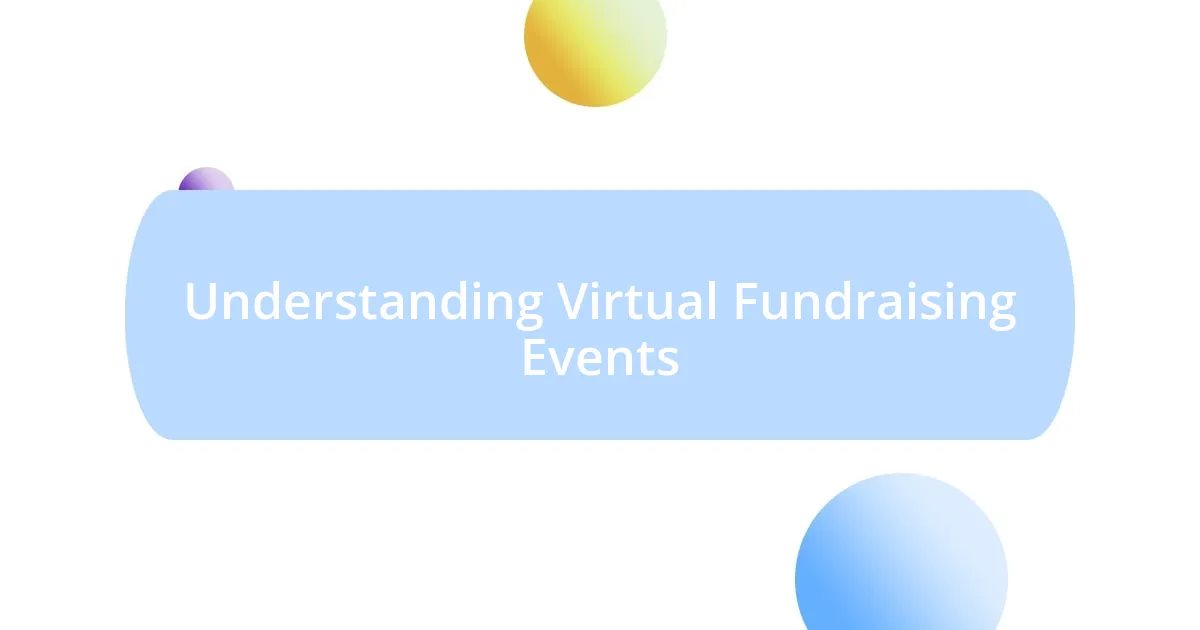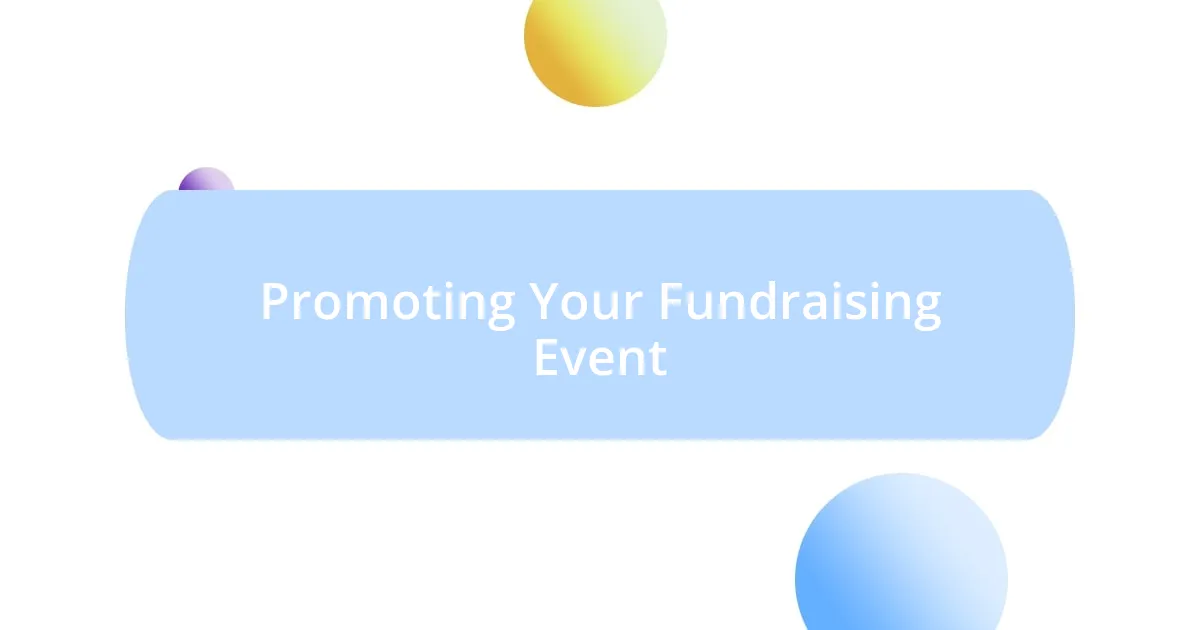Key takeaways:
- Virtual fundraising events have transformed traditional fundraising by fostering community and inclusivity despite geographical barriers.
- Utilizing interactive elements, storytelling, and real-time engagement can significantly enhance participant involvement and emotional connection.
- Post-event follow-up and analysis of performance metrics are essential for building stronger connections and optimizing future fundraising efforts.
- Social media promotions and partnerships with local businesses can amplify event reach and create a communal spirit, enhancing overall success.

Understanding Virtual Fundraising Events
Virtual fundraising events have completely transformed how organizations raise money. I remember my first experience attending an online charity gala—sitting in my living room, dressed up, and immersing myself in the event through my laptop. It struck me how technology can bridge distances and create a sense of community, even from afar.
When I think about these events, I can’t help but reflect on the unique challenges they present. For instance, engaging an audience virtually can often feel like speaking to a wall. There’s this constant push to create a genuine connection—how do you evoke emotion through a screen? One strategy I’ve seen work well is featuring impactful stories of beneficiaries, which brings a real human element to the online experience.
Ultimately, it’s fascinating to witness how organizations have adapted their traditional fundraising approaches to this digital landscape. I’ve learned that incorporating interactive elements, like polls or live chats, can keep participants energized and involved. It’s almost as if we’re all part of a tight-knit family, even though we’re physically miles apart. What do you think makes these events memorable for participants?

Benefits of Virtual Fundraising Platforms
When I reflect on the benefits of virtual fundraising platforms, I can’t help but appreciate how they expand reach beyond geographical limitations. I’ve participated in events where friends and family from different parts of the country could join in seamlessly. It fosters a sense of togetherness that I find incredibly heartwarming. The ease of sharing links and social media promotions means more people are exposed to causes they might not have discovered otherwise.
Here are some key benefits of virtual fundraising platforms:
– Broader Audience Engagement: Participants can join from anywhere, breaking down location barriers.
– Cost-Effectiveness: Hosting online events often saves on venue and catering costs, allowing more funds to go directly to the cause.
– Increased Accessibility: People with mobility issues or busy schedules can still participate, making it inclusive for all.
– Real-Time Analytics: Organizers can track engagement and donations instantly, allowing for quick adjustments to maximize fundraising efforts.

Key Tools for Successful Events
I’ve discovered that the technology behind virtual fundraising is crucial to its success. Types of platforms play a significant role in creating an engaging experience. For instance, I’ve seen how using a reliable video conferencing tool, like Zoom or Microsoft Teams, can allow for real-time interaction and engagement among participants. These platforms often come with features like breakout rooms, allowing donors to connect more personally, which I believe enhances the overall experience.
Another key tool is fundraising software. These tools, such as GiveLively and Donorbox, streamline donations and help organizations manage campaigns effectively. I remember attending an event where the host used a clever integration with social media. It transformed donations into a communal experience as people could see live updates on fundraising progress. For me, that real-time feedback brought a palpable energy to the event that’s hard to replicate elsewhere.
Let’s not overlook the importance of marketing tools. I’ve learned that a solid email campaign goes a long way in raising excitement before the event. Using tools like Mailchimp can help craft personalized invites that drive interest. Additionally, I often see organizers leveraging event pages on platforms like Eventbrite, which not only attract participants but also provide a place for community interaction before and after the event.
| Tool | Description |
|---|---|
| Video Conferencing Platforms | Facilitates real-time interaction and engagement for participants. |
| Fundraising Software | Streamlines donations and manages campaigns efficiently. |
| Marketing Tools | Helps craft personalized emails and attract participants through event pages. |

Engaging Your Audience Effectively
Engaging an audience effectively in virtual fundraising events requires a blend of creativity and passion. I’ve found that incorporating interactive elements, like polls or Q&A sessions, can turn a passive viewing experience into an active conversation. When I attended an event that involved real-time bidding for experiences, I felt an adrenaline rush that was palpable in the room—well, virtually speaking!
I’ve noticed that storytelling is a powerful tool in these settings. Sharing compelling personal stories about the cause or beneficiaries helps forge a connection with the audience. During one event I participated in, the host shared a heartfelt video showcasing the impact of donations on real lives. It not only moved me but also encouraged me and others to contribute more generously. Isn’t it fascinating how emotional narratives can trigger our giving instincts?
Moreover, I’ve learned that consistency is key. Engaging your audience doesn’t end with the event; maintaining connection through follow-up emails or social media updates keeps the enthusiasm alive. I remember after one fundraiser, the organizers sent a heartfelt thank-you message and shared how our contributions would make a difference. That simple act reinforced my commitment to the cause, making me feel valued and eager to participate again. How often do we consider the impact of our outreach after the spotlight has faded?

Promoting Your Fundraising Event
When promoting your fundraising event, I’ve found that tapping into social media can be a game changer. During my last virtual fundraiser, I saw firsthand how a clever countdown on Instagram Stories built anticipation and excitement among potential donors. It felt like we were all part of a collective movement, and that shared energy is something I truly believe can drive people to participate more actively.
Crafting engaging content for emails is another strategy that really resonates with me. I remember an event where the organizers sent out a series of teasers featuring stories of individuals who benefited from our support. Each email felt personal and warm, stirring an emotional connection that motivated me to spread the word. Wouldn’t you agree that authentic storytelling enhances invitees’ interest and encourages them to bring friends along?
Lastly, I suggest leveraging partnerships with local businesses or influencers. In one experience, a fundraising event partnered with a popular café offering a percentage of sales on the event day to the cause. I witnessed how this collaboration not only expanded the reach but also brought in a community spirit, blending in-person support with virtual engagement. Isn’t it inspiring how such partnerships can elevate an event from merely good to truly unforgettable?

Analyzing Event Performance Metrics
Analyzing metrics after a virtual fundraising event can provide valuable insights into what resonated with participants. I remember one event where we meticulously examined the data—registration numbers, engagement rates, and donation patterns. By identifying which segments captured the most attention, I learned that strategic timing in delivering key messages led to a significant increase in contributions. Isn’t it amazing how understanding these metrics can optimize future events?
I also found that monitoring chat engagement during the event unveiled trends in audience interest. For instance, at one fundraiser, the moments when attendees were most vocal aligned perfectly with donor match announcements. This correlation highlighted the impact of real-time incentives. It got me thinking: how often do we underestimate the power of audience interaction when crunching numbers?
Lastly, considering post-event surveys is an effective practice that I’ve come to appreciate deeply. After one memorable event, the feedback we gathered revealed not just what worked, but also areas for improvement. Participants shared their thoughts on pacing, content, and overall experience. I realized that inviting this kind of dialogue enriches the community’s involvement, making them feel heard and valued. Wouldn’t you say that these insights are a key ingredient for building stronger connections in future initiatives?

Lessons for Future Fundraising Efforts
I’ve discovered that creating an inclusive atmosphere during virtual fundraisers is vital for future success. In one event, we encouraged participants to share their personal stories in the chat, which transformed the experience into a supportive community gathering. It struck me how this simple act fostered a sense of belonging, reminding everyone that their voices mattered. Don’t you think inviting shared experiences can amplify connections and drive engagement?
Another lesson I’ve gleaned is the importance of follow-up communication post-event. After participating in an inspiring fundraiser, I was really touched when the organizers sent personalized thank-you notes and updates on how funds were being used. This not only reaffirmed my connection to the cause but also made me eager to participate in future events. Isn’t it fascinating how a little gratitude can go a long way toward nurturing lasting relationships?
Lastly, it’s crucial to embrace flexibility throughout the planning process. There was an event where unexpected tech issues arose, and instead of panicking, the team quickly transformed it into an interactive Q&A session. This adaptability not only kept the momentum going but also showed me the importance of being responsive to the moment. How often do we overlook the value of spontaneity in organized settings? Embracing these unpredictable twists can turn challenges into memorable opportunities for genuine interaction.














